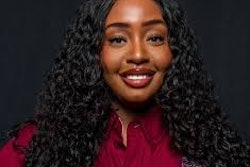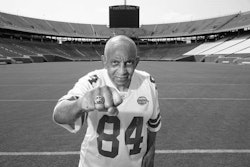Every Saturday night in the fall, university football quarterbacks around the nation get a moment in the spotlight. Cameras from ESPN, ABC, NBC, and Fox News center the faces of male athletes on the big screen.
Since the June 21 Supreme Court ruling on names, images, and likeness (NIL), NCAA college athletes are able to market themselves with third parties, not affiliated with a university, seeking sponsorship.
Many Saturday night stars have already signed agreements.
Louisiana State University (LSU) Quarterback Myles Brennan signed with Smoothie King; University of Miami quarterback D’Eriq King signed a sponsorship with College HUNKS Hauling and Junk Moving; University of Alabama quarterback Bryce Young signed with Cash App; Auburn University quarterback Bo Nix signed with Milo’s, a sweet tea company based in the south.
So far, many of the female athletes who signed an NIL agreement are social media influencers. Hanna and Haley Cavinder, twins on the Fresno State women’s basketball team, have 3.3 million TikTok followers and just signed a sponsorship deal with Boost Mobile. Olivia Dunne, a gymnast from LSU, has over 4 million TikTok followers and is in negotiations with several different companies, negotiating for upwards of seven figures.
For many of these young women, the opportunity to play a college sport exists because, almost fifty years ago, Title IX became federal civil rights law. Title IX states that “No person in the United States shall, on the basis of sex, be excluded from participation in, be denied the benefits of, or be subjected to discrimination under any education program or activity receiving federal financial assistance.”
Title IX does provide equal opportunity protection to private entities; but Title IX can actually play a crucial role in opening the door for female athletes to NIL opportunities, as the law requires universities to provide equal marketing and equal educational opportunities to all its athletes.
“If you think about NIL, it provides free market for student athletes," said Dr. Ketra Armstrong, professor of sport management and director of the Center for Race and Ethnicity in Sport at the University of Michigan. "If you think about that, how is the market for athletes determined? If you think about an athlete being able to capitalize, there is market value. How is market value established? This is where it gets into Title IX implications.”
Growing up, Armstrong played just about any sport she could. She adored basketball and played and coached at the college level. In the early 2000s, Armstrong was president of the NCAA Gender Equity Task Force. In many cases, she said, “men’s sports are marketed better than women’s sports. Often times they have a better market appeal, but sometimes it’s about what the school is doing. If the university is not marketing those women’s sports, they won’t have the same notoriety as the athletes that participate in sports that are highly marketed, highly coveted.”
Helen Drew, a professor of practice in sports law at the University at Buffalo, said that as long as universities work hard to promote all their athletes equally, they will be compliant with Title IX.
“If the university consistently provides information or press releases about every program on a nondiscriminatory basis, then it cannot be faulted if other outlets fail to publicize them equally,” she said.
But the relationship between marketing and anticipated media reception is complicated, like the chicken and the egg—which comes first?
"One of the arguments about lack of support for women’s sport is, ‘oh well we gotta follow the market. The young ladies have to understand the men’s tourney draws in more attention," said Dr. Bridget Niland, a former student athlete representative at the NCAA. "If you don’t promote it, how does it build its marketing power?”
Dr. Marcus A. Bright, a former student athlete academic coordinator and college athlete himself, said that media industries make choices about how and when they show and market women’s sporting events. But, he added, so do universities. Universities have the power to direct media attention towards its female athletes and has a “responsibility” to dig deeper to find creative ways to bring less commonly centered athletes and sports into focus, said Bright.
“Pressure has to be put on the status quo; awareness has to be heightened these inequities exist," said Bright who is a regular contributor to Diverse. "That way people can at least have an equitable shot at making the field.”
Bright said that universities should study the success of Simone Biles and her gymnastic team.
“What’s working with them and makes them so marketable? What aspects of that can we pump into women’s college athletics? How can we translate that even more so? This is reshuffling the deck to shed some new light on this issue, rethink strategies, and try different ways to increase the profile of women’s athletics,” he said.
Studies and numbers already indicate that there is an audience for women’s sports. During this spring’s college world series, the women’s softball games, aired on ESPN, averaged 1.2 million viewers, 60% more than the men’s tournament.
The social media savvy of athletes like the Cavinder twins and Dunne has helped them to create a market where there was not a market before. Unless, of course, a student does not have access to technology or is not social media adept. Which is why, to comply with Title IX, universities must ensure that all their student athletes receive the same opportunity and access to education so they can learn how to best market themselves to sponsors and what pit falls to avoid.
“Some athletes will be great at social media, others will need to be taught savvy skills, how to engage with potential people damning them or the mean, negative, rude comments that pop up," said Molly Harry, a PhD candidate at the University of Virginia. Her research focuses on intercollegiate athletics. "That comes down to the educational programming that schools will do in house or through a third party.”
Drew said that institutions are “scrambling to support their athletes. There’s a real concern that [they’ll] be offered opportunities that may or may not be good things, that may result in financial or tax consequences that [the students] may not be able to understand.”
She continued, “If you think about the horror stories of the successful professional athletes, like Michael Jordan being fleeced by unscrupulous agents—there’s the potential for that here.”
Institutional responsibility comes down to assistance and involvement. And this time of transition into NIL is going to be tricky for athletes and institutions alike. Still, there is a sense of optimism, especially for the new opportunities presented to young women, who typically have had few professional athletic options. Social media, said Niland, has changed everything, including the way we view sports.
“It’s not a simple picture, it’s not all good, it’s not all bad,” Niland said. “Hopefully it will empower young women to show us what they can do. This could be a real game changer.”
Liann Herder can be reached at [email protected].



















